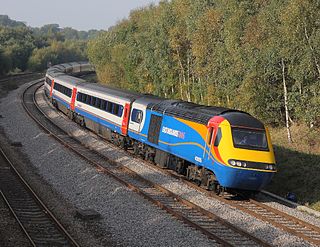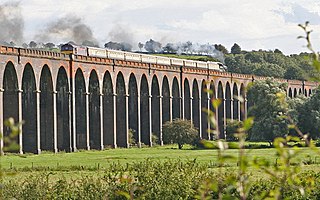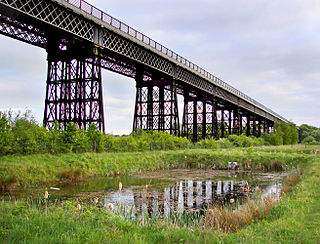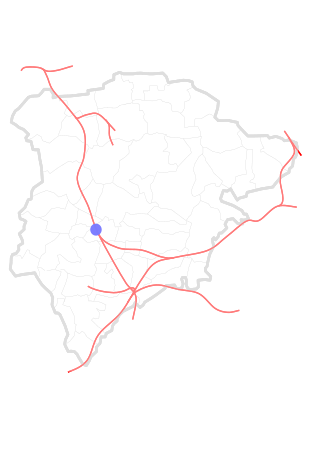
The Midland Main Line (MML) is a major railway line from London to Sheffield in Yorkshire via the East Midlands. It comprises the lines from London's St Pancras station via Leicester, Derby/Nottingham and Chesterfield.

Seaton is a village and civil parish in the county of Rutland in the East Midlands of England. The population of the civil parish was 178 at the 2001 census, including Stoke Dry and Thorpe by Water, increasing to 250 at the 2011 census. Nearby is the large Seaton Viaduct, on the Oakham to Kettering railway line. It is three quarters of a mile long and took four years to build. It has 82 arches which are up to 72 feet (22 m) high. For many years the railway was only used for freight traffic, but a restricted passenger service from Oakham to London via Corby and Kettering was opened in 2010. Seaton railway station, on a different line, closed in 1966.

Kettering railway station serves the market and industrial town of Kettering in Northamptonshire, England. It lies south-west of the town centre, on the Midland Main Line, 71 miles (115 km) north of London St. Pancras.

Corby railway station, owned by Network Rail and managed by East Midlands Railway, is in Corby, Northamptonshire, England. The current station, opened on 23 February 2009, replaces an earlier one dating from 1879, first closed on 18 April 1966 but reopened between 1987 and 1990.

Oakham railway station serves the county town of Oakham in Rutland, England. The station is situated almost halfway between Leicester – 27 miles (43 km) to the west – and Peterborough – 25 miles (40 km) eastward on the Syston and Peterborough Railway, the line is the Birmingham to Peterborough Line.

Melton Mowbray railway station serves the market town of Melton Mowbray in Leicestershire, England. It is owned by Network Rail and operated by East Midlands Railway, though CrossCountry operates most of the services as part of its Birmingham New Street to Stansted Airport route. The station is on the route of the Syston and Peterborough Railway, which is now part of the Birmingham to Peterborough Line. It has a ticket office, which is staffed part-time, a car park, and help points for times when no staff are present.

The Oakham–Kettering line is a railway line in the East Midlands of England. Currently it has one passenger station in operation, at Corby.

Bennerley Viaduct is a former railway bridge, now a foot and cycle bridge, between Ilkeston, Derbyshire, and Awsworth, Nottinghamshire, in central England. It was completed in 1877 and carried the Great Northern Railway's (GNR) Derbyshire Extension over the River Erewash, which forms the county boundary, and its wide, flat valley. The engineer was Samuel Abbott, who worked under Richard Johnson, the GNR's chief engineer. The site required a bespoke design as the ground would not support a traditional masonry viaduct due to extensive coal mining. The viaduct consists of 16 spans of wrought iron, lattice truss girders, carried on 15 wrought iron piers which are not fixed to the ground but are supported by brick and ashlar bases. The viaduct is 60 feet high, 26 feet wide between the parapets, and over a quarter of a mile long. It was once part of a chain of bridges and embankments carrying the railway for around two miles across the valley but most of its supporting structures were demolished when the line closed in 1968. The only similar surviving bridge in the United Kingdom is Meldon Viaduct in Devon.

The Ouse Valley Viaduct carries the London-Brighton Railway Line over the River Ouse in Sussex. It is located to the north of Haywards Heath and the south of Balcombe. Known for its ornate design, the structure has been described as "probably the most elegant viaduct in Britain."

Stockport Viaduct carries the West Coast Main Line across the valley of the River Mersey in Stockport, Greater Manchester, England. It is one of the largest brick structures in the United Kingdom and a major structure of the early railway age. It is immediately north of Stockport railway station.

Manton railway station or Manton Junction is a former railway station which served the villages of Manton and Wing in the county of Rutland.

Luffenham railway station is a former station of the Syston and Peterborough Railway serving the villages of North and South Luffenham, Rutland.

Seaton railway station was a station serving the villages of Seaton, Rutland, and Harringworth, Northamptonshire.

Harringworth railway station was a railway station near Harringworth, Northamptonshire. It was on the Oakham to Kettering Line of the Midland Railway, at grid reference SP912965 at the south end of Welland Viaduct.
The Rugby and Stamford Railway was an early railway in England built in 1850. The London and Birmingham Railway had already built a branch from Blisworth to serve Northampton and extend to Peterborough. The success of this, the Northampton and Peterborough Railway encouraged the directors to look for other ventures. They decided upon a branch from Rugby to Stamford which would link up with other new railways in the east of the country.

The London Road Viaduct is a brick railway viaduct in Brighton, part of the city of Brighton and Hove in East Sussex, England. It carries the East Coastway Line between Brighton and London Road railway stations. Built in the 1840s for the Brighton, Lewes and Hastings Railway by the locomotive engineer and railway architect John Urpeth Rastrick, the sharply curving structure has 27 arches and about 10 million bricks. It is still in constant use, and is listed at Grade II* for its historical and architectural significance.

Imberhorne Viaduct is a Grade II listed railway viaduct located in East Grinstead, West Sussex, South-East England. Closed in 1958, the structure was brought back into use as part of the preserved Bluebell Railway heritage line in 2013, allowing trains to continue to East Grinstead railway station.

Dinting Viaduct is a 19th-century railway viaduct in Glossopdale in Derbyshire, England, that carries the Glossop Line over a valley at the village of Dinting. It crosses the Glossop Brook and the A57 road between Manchester and Sheffield.

The Glebe and Wentworth Park railway viaducts are a series of two heritage-listed railway bridges and arch viaducts that carry the Inner West Light Rail across Wentworth Park, Jubilee Park, and Johnstons Creek in the inner western Sydney suburb of Glebe in the City of Sydney local government area of New South Wales, Australia. They were designed by the New South Wales Government Railways and built from 1892 to 1922 by day labour. They are also known as Wentworth Park Viaduct, Jubilee Park Viaduct and Glebe Viaducts. The viaducts were added to the New South Wales State Heritage Register on 2 April 1999.
The Nottingham direct line of the Midland Railway was a new route created in 1879 to relieve congestion on the established routes of the Midland Railway, in England. It consisted of two connecting lines that, together with part of an existing route, formed a new route from Nottingham to near Kettering. The line was used for Nottingham to London express passenger trains, and for heavy mineral and goods trains heading south. As well as shortening the transit a little, the new line had the effect of relieving congestion on the original main line through Leicester, that had become excessively congested.




















